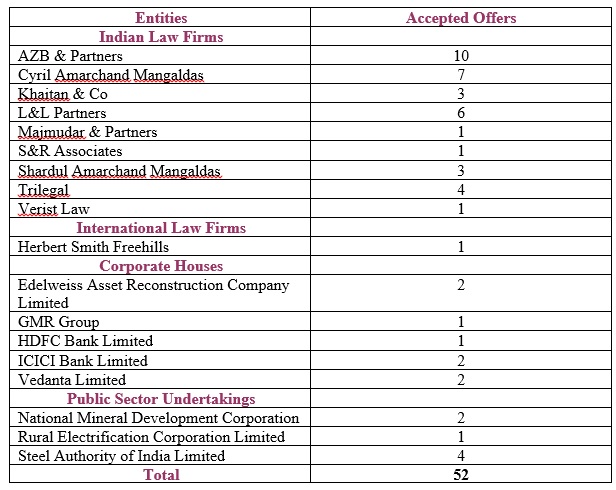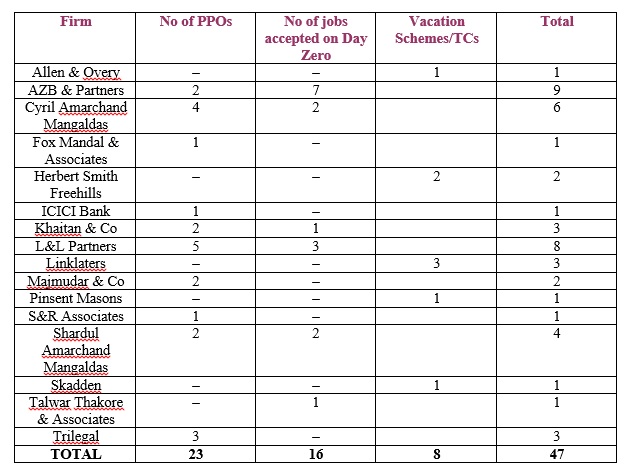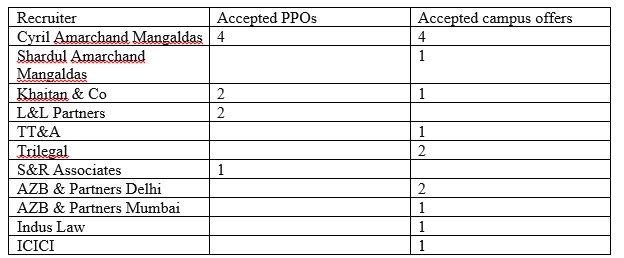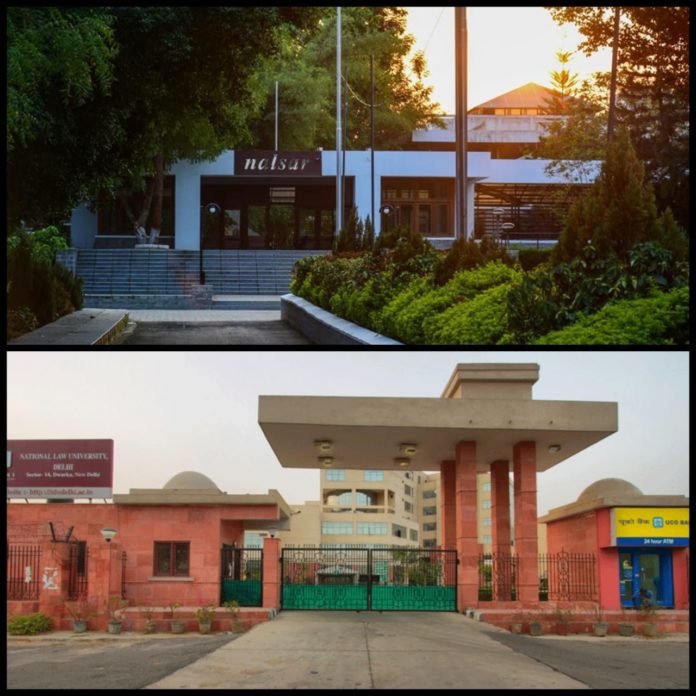This article is written by Harshvardhan Tripathi, a third year student at NALSAR University of Law, Hyderabad. Though the article is limited to two of the prestigious law schools in the country, it would be advisable to follow the method prescribed below for other law universities/colleges when you find yourself spoilt for choice.
At this juncture, for any CLAT aspirant, choosing a law school is the most crucial thing. One would not want to falter at the very first step of what is about to be a long arduous journey ahead. For most people, the choice of university is almost always swayed by CLAT Coaching centres and Internet reviews. While their authenticity cannot be discarded completely, I wonder if it actually reflects an intelligent and well-informed opinion that could be relied upon completely.
In 2017, I was to pick between NLU-Delhi and NALSAR, having secured AIR 3 AND AIR 118 in the respective tests. I remember being at my wit’s end, unable to base my choice on any concrete criteria, other than the prevailing notions and opinions, that were way out of touch with current realities. However, I sat down and dug deep on the Internet, and found some relevant factors that had to be accounted for, before picking the law school that suited my requirements.
Two years since, and the question still looms large in the heads of many. I’ve extended the list I used in 2017 to make it more comprehensive and inclusive of choices. Below is a ten-step process to pick your Law School right where I’ve mentioned ten possible factors that you might want to consider and compare in your law school.
The process is simple. Make a tally of points as you read and compare the pros and cons of both Universities.
In the first step, pick the factors that are actually relevant to you. For instance, you might strongly want to have a good range of courses in your law school along with low fee, but would be unaffected by flexibility of campus rules. Grade them on a scale of 0 to 3, based on how relevant they are to you: Irrelevant – 0, Slightly Relevant – 1, Sufficiently Relevant – 2, Extremely Relevant – 3.
In the second step, after having attached a grade to all 10 factors of comparison, read the details under each heading and enter how impressed you are with the details of each Law School, on a scale of 0 to 3. Your rating of the law school: Bad – 0, Just about okay – 1, Good – 2, Brilliant – 3.
To reach the third and final step, you will have to multiply the respective value you gave to each factor in Step 1 with the grading you have given to each law school in Step 2.
In the third and final step, total the tally and compare the final points. The choice should be obvious to you by the end of this exercise. The benefit of this weighed calculation would be that your more urgent priorities and requirements in a University will be better reflected in the final numeric result.
Factor 1: Location
NALSAR’s location is both its boon and bane. Located in Shamirpet village in Medchal district, NALSAR is located in a sparsely populated area, 25 kms away from the urban part of Hyderabad. This makes any trip to the city simultaneously rare, expensive, and time consuming. To a large extent, the fact of a campus being situated at such distance from the city nullifies any chances of visiting Courts, Law firms or Tribunals after class hours, which in my opinion is a huge drawback. Moreover, travelling to other cities from Hyderabad for attending Moot Courts, Conferences, MUNs, ADR Competitions etc. could be a costly affair.
On the flip side, the surroundings and lush green campus of the University offers a break from the quick-pacing metropolises life. Evening walks into the wilderness have often made me appreciate the poetry in motion around me. Nature enthusiasts certainly have a treat to feast their eyes on. People in the nearby village are mostly friendly and welcoming, and one can manage barely even without knowing Telugu. However, a functional knowledge of language makes everyday interactions outside campus much easier.
You’d find most things of subsistence nearby, but if you’re expecting a plethora of ranges, forget it. Shops nearby are few and slightly over-priced. However, most e-commerce websites like Amazon, FlipKart, Snapdeal, BigBasket and likewise deliver couriers almost daily at the campus gate. But if you’re craving a McBurger or a Sub, you’re in for a huge disappointment. There’s no food delivery service other than a local one. The college satiates the taste bud craving during myriad college fests on food-trucks, but that hardly cuts the deal.
Situated in the sub-city of Dwarka, NLU-Delhi is at a much more accessible location. Besides the obvious proximity to the Supreme Court and the High Court, attending major conferences/workshops/moots is less of a hassle, on account of most of such events being organized in Delhi itself. However, given the long class timings and campus in-time rule at NLU-Delhi, I am not sure of how far these opportunities are feasible to students there in real terms. However, one can still draw a reasonable inference that the location of NLU Delhi offers a much more feasible access to educational opportunities than NALSAR.
Factor 2: Placements
If placement in Law Firms is one of your top priorities, the good news is that both these law schools have a top-notch placement record with almost all big Indian and International firms recruiting from campus. There’s also a burgeoning number of students opting for higher education degrees in prestigious international universities, the details of which can be found in the links mentioned below. In terms of the extent of alumni base, NALSAR has an advantage over NLU-Delhi, on account of being established a decade earlier. The most recent of statistics are:
NALSAR
5th Year Placement Figures for 2019

Day Zero 2019:

NLU-Delhi
Day Zero 2019

Factor 3: Research Centres
Both institutes boast a large number of research centres established with the aim of undertaking intensively focused research in niche areas of law. Following is a non-exhaustive list of the same:
NALSAR: Centre for Air and Space Law, Centre for Constitutional Law, Public Policy and Good Governance, Centre for Corporate Governance, Centre for Disability Studies, Centre for Family Laws, Centre for Legal Philosophy and Justice Education, Centre of Excellence for Economics and Finance, S. P. Chatterjee Centre for Environmental Law Studies, M K Nambyar SAARCLAW Centre for Advanced Legal Studies and C. Banerjee Centre for Intellectual Property Rights Studies.
NLU Delhi: Centre for Innovation, Intellectual Property and Competition (CIIPC), Centre for Constitutional Law, Policy and Governance, Centre for Banking and Financial Laws, Centre for Communication Governance, Centre for Corporate Law and Governance, Centre on Death Penalty, Centre for Transparency and Accountability in Governance and Centre for Transnational Commercial Law.
Factor 4: Publications and Blogs:
The corpus of quality research produced by a law school is its hallmark of excellence. To a great extent, it is indicative of the growing academic stature of an institution and the areas of law currently being explored in-depth at the University Campus. If you’re inclined towards academic writing, or would be willing to explore the same sometime in future, following is a non-exhaustive list of journals and publications at both Law Schools:
NALSAR: NALSAR Law Review (ISSN 2319-1988), Indian Journal of Intellectual Property Law (Print ISSN 0975-492X and e-ISSN 2278-862X), Environmental Law and Practice Review (ISSN 2319-1856), Media Law Review (ISSN 2319-1848), Journal of Corporate Affairs and Corporate Crimes (ISSN 2278-8611), NALSAR Student Law Review (ISSN 0975-0216), The Indian Journal of Constitutional Law (ISSN 0975-0134), The Indian Journal of Law and Economics (ISSN 2319-1864), NALSAR ADR Journal (ISSN 2348-7690), International Journal of Constitutional Law (IJCL) and NALSAR International Law Journal
Blogs: Technology Law Forum, Nyaya Policy Research and NALSAR International Law Society Blog
NLU-D: Journal of National Law University Delhi, NLUD Student Law Review, The International Journal of Transparency and Accountability in Governance, NLU Delhi, ISSN NO: 2395-4337, The Indian Journal of Criminology and Journal of Victimology and Victim Justice
List of other publications: (https://nludelhi.ac.in/res-pub-ins.aspx)
Factor 5: Range of Courses offered:
As opposed to the mandatory courses that are offered almost commonly throughout India, in line with the requirements of the BCI, it is the unique group of elective and seminar courses offered at each law school, that counts for its Academic Curriculum USP. Depending upon your inclination, you might want to pick courses of interdisciplinary humanities or more industry pertinent advanced law courses.
NALSAR: https://clatconsortiumofnlu.ac.in/nlu/brochure/NALSAR.pdf (Page 3-5)
NLU-D: https://nludelhi.ac.in/acd-osc.aspx
Factor 6: Affordibility:
Legal education in elite law schools is cheap by no standards. Estimating the Return-on-Investment for the law school degree you are about to pursue is an economically sound choice to make. It’d be advisable to plan your finances, perhaps by taking an educational loan, if you require one, in accordance with the fee structure followed at both places. Luckily, fee Concessions/Scholarships are provided to economically weak and meritorious students.
NALSAR: The fee structure totals up to Rs. 2,42,000 per annum and the detailed break-up is available in the brochure that can be accessed on this link: https://clatconsortiumofnlu.ac.in/nlu/brochure/NALSAR.pdf (Page 9)
NLU-D: The fee structure totals up to Rs. 1,86,000 per annum and the detailed break-up is available on this link: https://nludelhi.ac.in/adm-ba.aspx
Factor 7: Details of Faculty Members and their Educational Qualification:
Is being taught by some of the most acclaimed Academicians in our country your priority? Take a sneak-peek at who you’d be possibly encountering in classrooms on a daily basis, and choose your gurus wisely. If possible, get in touch with students currently studying at both Law Schools, to get an honest review of the caliber of the present faculty group.
NALSAR: Read the Detailed NIRF report by clicking on the following URL:
https://drive.google.com/file/d/0B_mRrj8MBDYUnpyVlZycTA4QmE1SGd0NzREeFByYWMtUy1r/view?usp=sharing
NLU-D: Link to NLU- Delhi’s website containing Faculty profiles:
https://nludelhi.ac.in/pep-fac.aspx
All achievements: https://nludelhi.ac.in/download/2017/jan-2017/Recruitment%20Brochure%202016.pdf
Factor 8: Flexibility of the Campus Rules:
It might be worthwhile looking at what rules and restrictions are in place at the Law School you are about to join. From the Entry and Exit timings of Campus/Hostel to the corpus of fine you’ll be paying when caught boozing for the first time, it’s all there!
NALSAR: Campus in-time: 10 p.m. ; Hostel/Residence in-time: 3 a.m.
Link to a slightly outdated Copy of University and Hostel Rules(2018): https://drive.google.com/open?id=0B9JUu6gxJ3GZSmpCZDdrS2Vfci1IT3VTc2U3b255ZmVYRUdN
NLU-D: Campus in-time: 6 p.m. ; Hostel/Residence in-time: 10 p.m.
(Notable: Para. 5 of Campus rules: “…….Students should return to campus by 6.00 p.m. …………. The Time to get back to the Halls of Residence is by or before 10:00 p.m.”)
Link to the Campus Rules of NLU-D access it on: https://nludelhi.ac.in/stu-crr.aspx
Factor 9: Inputs from people currently studying in NLU_D and NALSAR:
Nothing could be closer to truth than the input of those currently studying in the two law schools. Reach out to them, and try gathering every minute detail that concerns you about these places.
Factor 10: Mooting and ADR Achievements:
Moot Court Competitions, Mediation, Negotiation, Arbitration, Client Counselling etc. are some of the exciting extra-curriculars activities you can opt for in both law schools. Since these skills are mostly gained by practice and experience, having a group of expert and seasoned seniors on campus for guidance is a sine qua non. Following is a non-exhaustive list of achievments in various competitions for both law schools:
NALSAR MOOTING AND ADR ACHIEVMENTS(2018):
NLU-D MOOTING AND ADR ACHIEVMENTS (2018):
https://nludelhi.ac.in/download/2017/jan-2017/Recruitment%20Brochure%202016.pdf (Page 13-14)
As mentioned, this article is only limited to NALSAR, Hyderabad and NLU-Delhi. We always encourage our subscribers to pursue advice that seems well-reasoned and to seek for guidance from present students of the college that you wish to spend the next five years at. We would be glad to receive any articles written on a particular law university/college that might help students in the future to make an intelligent decision. Please write to us at clatgyan@gmail.com for more details.
















thank you!
Thank you so much for this article
The campus in-time for NLUD hasn’t been updated over the website, perhaps. It’s 10 p.m. for campus and 12 a.m. for hostels. Further, the implementation of these timings is also quite lax. So, I don’t think that would be a problem at NLUD. However, Delhi being Delhi, it’s safer being on campus in time.:p
There’s an error with the intone stated. Currently the intime for hostel is 12am and for the gates it’s 10pm. Hope you rectify this error. The rules have not been updated.
thank you, this was really helpful 🙂
Just one clarification. In NLU Delhi there are not very long working hours. Running internships are more common in 4th and 5th year and they have four and two classes per day respectively. For first three years, technically the classes have to end at 3:30, 1 hr break inclusive, but many of the times, the last hour is free (that is completely up to the discretion of the concerned Professor) and the classes get over at 1:20 with lunch break following it.
Also, one more thing that is relevant for NLUD is that here is a requirement for 95% attendance per semester. There are 5 marks kept reserved for attendance per subject. 95-100%–5 marks, 90-95%–4 marks…
However a minimum of 75% is required for appearing in exams.
Do get back for any other clarification.
Saloni
NLU Delhi
i am getting NLSIU and NLUD both which should i choose ? Also i am interested in UPSC